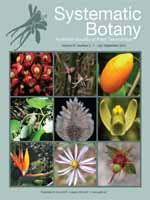Eriogonoideae s. s. (buckwheats and spineflowers, Polygonaceae) comprises morphologically diverse plants (ca. 325 species, 20 genera) distributed amphitropically in the New World. The lineage is hypothesized to have recently diversified mostly in arid habitats of the western U. S. A., where species richness and endemism are highest. Generic classification of Eriogonoideae s. s. has been unstable, mostly due to different morphological interpretations of the involucre. In this study, phylogenetic relationships of Eriogonoideae s. s. were estimated using multiple genes (ITS, trnL—F and psbD—trnT), optimality criteria (Bayesian, Garli ML and RAxML), and a large taxonomic sample (n = 160). Tribes Pterostegieae and Eriogoneae are monophyletic and subtribes Chorizanthineae and Eriogoneae are paraphyletic. The largest genera (Eriogonum and Chorizanthe) and most subgenera are paraphyletic. Most taxonomic groups shown to be non-monophyletic in phylogenies are also rejected for monophyly using the Shimodaira-Hasegawa test. With a primary goal of informing future taxonomic changes, major clades are identified that may be referrable to generic or infrageneric groups within Eriogonoideae s. s. Also, hypotheses regarding the variation of inflorescence features among Eriogonoideae s. s. are discussed.
How to translate text using browser tools
1 September 2012
Systematics of Eriogonoideae s. s. (Polygonaceae)
Elizabeth A. Kempton
ACCESS THE FULL ARTICLE

Systematic Botany
Vol. 37 • No. 3
July 2012
Vol. 37 • No. 3
July 2012
Adaptive radiations
Chorizanthe
Eriogonum
morphological homoplasy
Mucronea
Shimodaira-Hasegawa test




